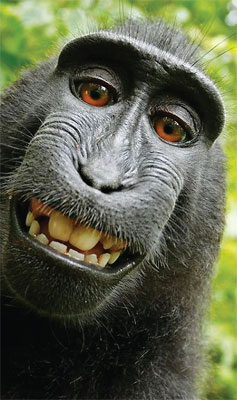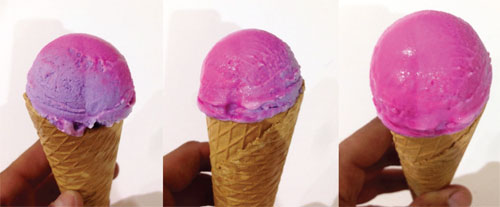NEWS around the world
Who owns the rights to this monkey selfie?
 If a monkey takes a photograph, who owns the rights to it? The monkey
or the owner of the camera? That’s the question being discussed all over
the Internet about this toothy selfie a macaque monkey “took” of itself
with photographer David Slater’s camera. If a monkey takes a photograph, who owns the rights to it? The monkey
or the owner of the camera? That’s the question being discussed all over
the Internet about this toothy selfie a macaque monkey “took” of itself
with photographer David Slater’s camera.
Slater travelled to Indonesia in 2011 to get the perfect image of a
black crested macaque. One of the monkeys came to check out his camera
and took hundreds of photos of itself accidentally.
Most of the photos were blurry, but one of them was a cute
self-portrait of a monkey appearing to grin.Now the image, and another
in-focus selfie, has been uploaded to Wikipedia and Slater is not
pleased. He has asked Wikimedia, the organisation behind Wikipedia, to
remove the image from its pages because he owns the rights to it. It is
included in an image library that allows other websites to use it for
free, it is harming his right to make money from “his” photo.

Wikimedia Commons is a collection of over 22 million images and
videos that are free to use online. Because the photos are on that site,
people are free to use it and republish it without having to pay Slater
a sum of money, known as a royalty, to use it.
But Wikimedia says that because the monkey pressed the button to take
the photo, Slater does not own the right to the photo and it is
uncopyrightable.
Copyright Compendium, a copyright law, states that animals cannot own
copyrights. “The term ‘authorship’ implies that, for a work to be
copyrightable, it must owe its origin to a human being.
Materials produced solely by nature, by plants, or by animals are not
copyrightable.”Slater argues that the image was not produced solely by
the macaque because a monkey pressed a button, but he did all the
setting up.“If the monkey took it, it owns the copyright, not me; that’s
[Wikimedia's] basic argument. What they don’t realise is that it needs a
court to decide that. I’ve told them it’s not pubic domain, they’ve got
no right to say that it’s public domain,” explained Slater.
What do you think? Does this image belong to Slater or is it
uncopyrightable? -Internet
Look before and after you lick!
It seems too good to be true, but a Spanish physicist has invented a
colour-changing ice cream that changes shades as you lick it!
The ice cream is called Xamaleon, and so far Manuel Linares, its
inventor, has only created one flavour, tutti-frutti. It turns from pale
purple to fuchsia with a lick of the tongue.

Linares studied Electrical Engineering and Physics but is currently
teaching high school Physics and Math. He invented Xamaleon when he
enrolled in the Hoffman School of Cuisine to get rid of some of the
stress brought on by teaching.
Linares developed a knack for making ice cream and became a student
of ANHCEA (Natural Business Association of Artisans and Merchants
Processors of Ice Cream and Horchatas). There his teacher proposed lots
of ice cream-related challenges –creating hot ice cream was one of them.
He specifically challenged physicist Linares to come up with a colour-changing
ice cream.
Linares didn’t think his invention would be such a big deal, but so
far since he launched Xamaleon in June he’s received calls and emails
from small ice cream businesses in Singapore, Russia, Germany, Miami who
are looking to sell it.
Linares’ formula for Xamaleon is a secret, but we do know it’s made
with cocoa, strawberries, almonds, banana, pistachio, vanilla, caramel
and “exotic fruits.”
The future of Xamaleon looks bright, but Linares isn’t getting too
excited yet. He plans to keep teaching in the fall and see where
Xamaleon takes him.
“I don’t quite understand, with all this money that is moved [in the
ice cream business] in the summer season, how nobody took this route
before,” he said. “I always thougt physicists were not supposed to be
imaginative but [come on]! All that is needed is just a little bit of
imagination.”
-Internet |

